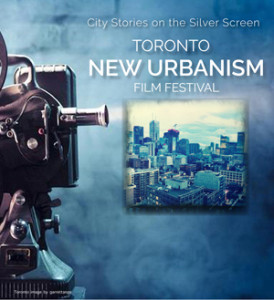 The Congress for the New Urbanism Ontario, in partnership with Jane’s Walk and the University of Toronto’s Urban Studies Program will present the inaugural Toronto New Urbanism Film Festival on April 21 and May 26 at 6:30 p.m. at the Innis Town Hall at 2 Sussex Ave. on the UofT campus.
The Congress for the New Urbanism Ontario, in partnership with Jane’s Walk and the University of Toronto’s Urban Studies Program will present the inaugural Toronto New Urbanism Film Festival on April 21 and May 26 at 6:30 p.m. at the Innis Town Hall at 2 Sussex Ave. on the UofT campus.
The films being screened throughout this festival focus on grassroots initiatives on a wide range of urban issues in the U.S.A and Canada: from recreational to transportation needs, and from economics to healthy living and environmental issues.
Program Overview:
Part 1 – Thursday, April 21st 2016
- Arlington Passages (Arlington): A retired environmental lawyer starts a new business in real estate, showing houses by bicycle. She’s found it to be the best way for her clients to get a sense of the neighborhoods she serves.
- Progressive Transit in a Conservative State (Salt Lake City): Salt Lake City built a mass transit network to connect the suburbs to the downtown. This street films video shows how mass transit can be the environmental and economic solution to urban revitalization.
- Vancouver Cycle Chic (Vancouver): Cecily is a librarian in Vancouver who suffers from rheumatoid arthritis but started biking to work for health reasons. She shows that inner city bicycling doesn’t have to be spandex and carbon bikes, but can be effortlessly stylish and fun.
- Urban Freeway Removal (Dallas): This is a Street Films presentation featuring John Norquist. It discusses NYC, Vancouver, San Francisco, Seattle, Dallas, and more!
- Cerebral City (Melbourne): This is the 2015 winner for best urban design film. It talks about the transition of Melbourne from a 9-5 downtown to a real downtown. They discuss open public plazas, alleyway revitalization, transit, complete streets, and activated streets as tools for creating a lovely place to live and work.
- Do Season (Fredricton): This was the runner up for our Urbanism Economies award. The film highlights a program for entrepreneurs who want to put down roots in their town and develop equity. Very inspiring.
- MemFix (Memphis): A program in Memphis that unites small business and tactical urbanism projects to create a new business district on the edge of Memphis. Winner of the Best Short Film on Economics of Urbanism.
- The Fresno Miracle (Fresno): The City of Fresno was rewriting their master plan. And “the miracle” was how many people got engaged in the planning process. The film touches on themes of art districts ability to act as revitalization, and economic engine. The main thrust of the film is centered on the threat of expanding suburbs encroaching on the rich, historic farmland surrounding Fresno.
- Frog Town (Los Angeles): The Los Angeles River is 51 miles long and cuts through the heart of the city. However in the 1930s the army corp of engineers cemented into one long channel. Today it is kind of ugly, cumbersome, piece of infrastructure. However different groups are trying to restore the river with natural vegetation and are re-imagining it as a beautiful, recreational center piece of the city. This short film highlights the history of one corner of the river known as Frogtown.
- Stolen Bike NYC (New York City): Filmmaker Casey Neistat installs a much needed bike rack in front of his office building. The city forces him to remove it, but still the video is enlightening and funny.
- Awesome Tampa Bay (Tampa): This film tells one piece of the story of The Urban Conga. A group dedicated to reactivating urban spaces. One of the group’s projects was a ping pong table installed in a downtown park. Paddles and balls can be checked out at the surrounding businesses. The table activates a park in a barren downtown.
- I Rather Stay (Vancouver): I’d Rather Stay shares the intimate stories of five older adults, living in different Greater Vancouver neighbourhoods. From dense urban centres to car dependent suburbs, the film delves into their day-to-day lives and explores personal issues of mobility, vulnerability, and resilience.
- SagaCity (Ottawa): The is an animated film that touches on every aspect of the new urbanism movement. It advocates development of all kinds, from downtown revitalization to sprawl retrofit, and provides the various motivations for pursuing it: environmental concerns, individual health, fiscal sustainability of the city, and general life style.
- The Road to School (Ottawa): This video was shot in Cap-Rouge, Quebec. It follows two young students as they undertake the 650 meter walk that separates their home from their school. The road they need to walk is far from being safe, prompting many parents to choose the car as the family’s primary means of transportation. The lack of adequate pedestrian infrastructure is in large part responsible for the staggering decrease in the number of students walking to school in Quebec.
- Landfills: From Guppies to Yuppies (Boston): Artists and entrepreneurs battle over a piece of Boston cream pie: a prized geographical area known as Fort Point, which started out as landfill. Two hundred years ago the section of Boston called Fort Point did not exist. It was reclaimed from the ocean by landfill and became New England’s oldest and largest visual artists community. “Landfill” is a short documentary about the lively battles between the Fort Point artists and the entrepreneurs dramatically changing the area.
Part 2 – Thursday, May 26th 2016
- Atelier Da Rua (Portugal): This short animation explains how Atelier Da Rua is a project to talk, think, design and build our streets collectively;
an urban design methodology towards a more participated city, linking local and global, traditional and innovative resources; a tool for projects imagined, designed and built with the community throughout the different stages of the process to improve the public space and create more human and valued places. - Borrowed Light (Maryland): Animated story celebrating the beauty of communities coming together after a crook steals all the light bulbs.
- The Building of Business (Memphis): Broad Avenue brings businesses to a developing neighbourhood by matching them with available spaces on the street.
- Brooklyn Farmer (Brooklyn): The film explores the unique challenges facing Brooklyn Grange, a group of urban farmers who endeavor to run a commercially viable farm across the rooftops of New York City. As their growing operation expands to a second roof, the team confronts the realities inherent in operating the world’s largest rooftop farm in one of the world’s biggest cities.
- Graftstract (Bronx): By enlisting the help of some of the world’s top street artists, J. “SinXero” Beltran has made it his mission to legally beautify the Bronx, the birthplace of graffiti, through his TAG Public Arts Project (The Art of Grafstract).
- Mary Mattingly’s Waterfront (New York): Over the course of the summer and fall of 2013, artist Mary Mattingly constructs and occupies “Triple Island” (2013), an outdoor sculpture overlooking the East River in Lower Manhattan. Situated in the newly developed Pier 42 public park — a waterfront area flooded by Hurricane Sandy in 2012 — the sculpture rests on buoyant 55 gallon drums, which allow it to float in the event of rising sea levels.
- Neistat Bike Lanes Crashing (New York): When Casey Neistat got ticketed for not riding in a bike lane, he didn’t just get mad. He made a film and got even.
- New Urban Film Festival (Everywhere): Sprawl is the greatest threat to humanity, New Urbanism AKA old urbanism is the solution.
- Seaside (Florida): A planned seaside community that sparked the ‘New Urbanism’ movement and where the Truman Show was filmed.
- Streets of Art (Buffallo): The film chronicles the revitalization of Buffalo NY through the efforts of street artists. Street art adds to a sense of place, community, and ideals.
- The Edible Bus Stop (London): The Edible Bus Stop is a project that germinated from the need for green space within our cities and built environments. The Edible Bus Stop transforms neglected urban public sites into design-led, community growing spaces.
- Work the Landscape (United Kingdom): Child Like drawings explain city planning, urbanism and greening.
Admission
General admission tickets are $10 for CNU members, $12 for non-members and $5 for students.
Double bill tickets are $15 for CNU members, $18 for non-members. All tickets can be purchased online by visiting http://cnuontario.org/nu-film-festival/.
For more information, please contact the Congress for the New Urbanism – Ontario Chapter – ontario@cnu.org.
 TheBulletin.ca Journal of Downtown Toronto
TheBulletin.ca Journal of Downtown Toronto


